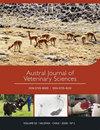Dairy cow behaviour around calving: Its relationship with management practices and environmental conditions
IF 0.8
4区 农林科学
Q3 VETERINARY SCIENCES
引用次数: 7
Abstract
Calving is one of the most challenging and painful experiences for dairy cattle and a process that involves coping with physical and physiological changes, as well as environmental and management-related stressors. In recent years, it has been argued that the application of cow behaviour knowledge might facilitate their efficacious management during calving. This review aims to summarise and discuss current knowledge regarding the behavioural changes that occur around calving time. The relationship between calving behaviour, management practices, and environmental conditions in dairy cattle raised in intensive indoor production systems, as well as pasture-based systems, is also discussed. First, we briefly outline the process of parturition and the concept of maternal behaviour. We then describe behavioural changes that occur around parturition in normal and dystocic births and how variations in these behaviours can be used to predict normal or assisted calving in dairy cattle; particular emphasis is placed on the role of feeding, rumination, and lying behaviour. Finally, we review how management practices and environmental conditions can influence cow’s behaviour at calving and discuss the importance of providing an environment that accommodates the behaviour they are motivated to perform. This review presents evidence that the time a cow is moved to the calving area, the type of group housing and the provision of a secluded area to calve, can impact the behavioral responses of dairy cows at calving. Evidence regarding the effects of exposure to environmental conditions such as heat during summer, and/or cold, wet and mud during winter can also have a negative impact on behaviour, suggesting potential benefits of providing cows with a protected area to calve. We conclude that a better understanding of the behaviour of parturient cows may help producers improve the care and management around calving time.奶牛产仔行为与管理实践和环境条件的关系
产犊是奶牛最具挑战性和最痛苦的经历之一,这一过程涉及应对身体和生理变化,以及环境和管理相关的压力源。近年来,人们一直认为应用奶牛行为知识可以促进它们在产犊期间的有效管理。这篇综述的目的是总结和讨论目前关于在产犊期发生的行为变化的知识。还讨论了在集约化室内生产系统以及牧场系统中饲养的奶牛的产犊行为、管理实践和环境条件之间的关系。首先,我们简要概述了分娩过程和产妇行为的概念。然后,我们描述了正常分娩和难产分娩时发生的行为变化,以及这些行为的变化如何用于预测奶牛的正常或辅助产犊;特别强调的是喂养,反刍和说谎行为的作用。最后,我们回顾了管理实践和环境条件如何影响奶牛在产犊时的行为,并讨论了提供一个适应它们被激励的行为的环境的重要性。这篇综述提供的证据表明,奶牛被转移到产犊区的时间、群体住房的类型以及提供一个隐蔽的产犊区域,都会影响奶牛在产犊时的行为反应。有证据表明,暴露在夏季炎热和/或冬季寒冷、潮湿和泥泞的环境条件下也会对行为产生负面影响,这表明为奶牛提供一个受保护的产仔区域可能会带来潜在的好处。我们的结论是,更好地了解奶牛的行为可以帮助生产者改善产犊期的护理和管理。
本文章由计算机程序翻译,如有差异,请以英文原文为准。
求助全文
约1分钟内获得全文
求助全文
来源期刊

Austral Journal of Veterinary Sciences
Veterinary-General Veterinary
CiteScore
1.60
自引率
0.00%
发文量
18
期刊介绍:
Austral Journal of Veterinary Sciences (formerly Archivos de Medicina Veterinaria) publishes original scientific contributions in English, containing the latest developments and discoveries in veterinary sciences. The journal covers topics such as animal health and production, preventive medicine, zoonosis, pharmacology and therapeutics, methods of diagnosis, and other areas related to the veterinary field.
Austral Journal of Veterinary Sciences aims to divulge information about advances in veterinary medicine among universities, research centres, industries, government agencies, biologists, agronomists and veterinarians.
 求助内容:
求助内容: 应助结果提醒方式:
应助结果提醒方式:


